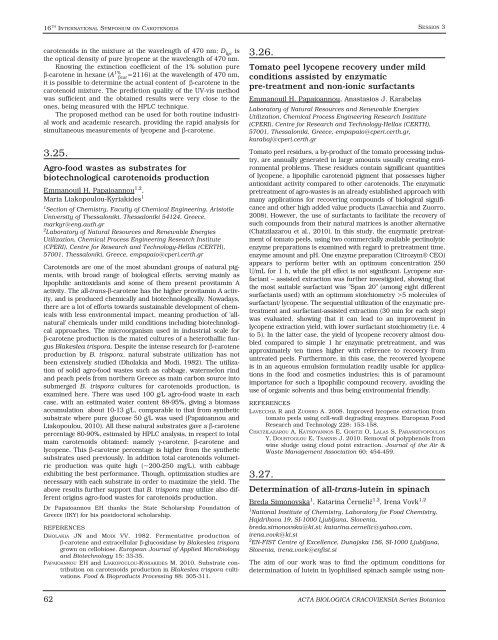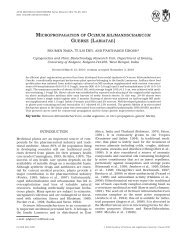ACTA BIOLOGICA CRACOVIENSIA
ACTA BIOLOGICA CRACOVIENSIA
ACTA BIOLOGICA CRACOVIENSIA
Create successful ePaper yourself
Turn your PDF publications into a flip-book with our unique Google optimized e-Paper software.
16 TH INTERNATIONAL SYMPOSIUM ON CAROTENOIDS<br />
carotenoids in the mixture at the wavelength of 470 nm; Dlyc is<br />
the optical density of pure lycopene at the wavelength of 470 nm.<br />
Knowing the extinction coefficient of the 1% solution pure<br />
β-carotene in hexane (A 1%<br />
βcar<br />
=2116) at the wavelength of 470 nm,<br />
it is possible to determine the actual content of β-carotene in the<br />
carotenoid mixture. The prediction quality of the UV-vis method<br />
was sufficient and the obtained results were very close to the<br />
ones, being measured with the HPLC technique.<br />
The proposed method can be used for both routine industrial<br />
work and academic research, providing the rapid analysis for<br />
simultaneous measurements of lycopene and β-carotene.<br />
3.25.<br />
Agro-food wastes as substrates for<br />
biotechnological carotenoids production<br />
Emmanouil H. Papaioannou1,2 ,<br />
Maria Liakopoulou-Kyriakides 1<br />
1 Section of Chemistry, Faculty of Chemical Engineering, Aristotle<br />
University of Thessaloniki, Thessaloniki 54124, Greece,<br />
markyr@eng.auth.gr<br />
2 Laboratory of Natural Resources and Renewable Energies<br />
Utilization, Chemical Process Engineering Research Institute<br />
(CPERI), Centre for Research and Technology-Hellas (CERTH),<br />
57001, Thessaloniki, Greece, empapaio@cperi.certh.gr<br />
Carotenoids are one of the most abundant groups of natural pigments,<br />
with broad range of biological effects, serving mainly as<br />
lipophilic antioxidants and some of them present provitamin A<br />
activity. The all-trans-β-carotene has the higher provitamin A activity,<br />
and is produced chemically and biotechnologically. Nowadays,<br />
there are a lot of efforts towards sustainable development of chemicals<br />
with less environmental impact, meaning production of 'allnatural'<br />
chemicals under mild conditions including biotechnological<br />
approaches. The microorganism used in industrial scale for<br />
β-carotene production is the mated cultures of a heterothallic fungus<br />
Blakeslea trispora. Despite the intense research for β-carotene<br />
production by B. trispora, natural substrate utilization has not<br />
been extensively studied (Dholakia and Modi, 1982). The utilization<br />
of solid agro-food wastes such as cabbage, watermelon rind<br />
and peach peels from northern Greece as main carbon source into<br />
submerged B. trispora cultures for carotenoids production, is<br />
examined here. There was used 100 g/L agro-food waste in each<br />
case, with an estimated water content 88-95%, giving a biomass<br />
accumulation about 10-13 g/L, comparable to that from synthetic<br />
substrate where pure glucose 50 g/L was used (Papaioannou and<br />
Liakopoulou, 2010). All these natural substrates gave a β-carotene<br />
percentage 80-90%, estimated by HPLC analysis, in respect to total<br />
main carotenoids obtained: namely γ-carotene, β-carotene and<br />
lycopene. This β-carotene percentage is higher from the synthetic<br />
substrates used previously. In addition total carotenoids volumetric<br />
production was quite high (~200-250 mg/L), with cabbage<br />
exhibiting the best performance. Though, optimization studies are<br />
necessary with each substrate in order to maximize the yield. The<br />
above results further support that B. trispora may utilize also different<br />
origins agro-food wastes for carotenoids production.<br />
Dr Papaioannou EH thanks the State Scholarship Foundation of<br />
Greece (IKY) for his postdoctoral scholarship.<br />
REFERENCES<br />
DHOLAKIA JN and MODI VV. 1982. Fermentative production of<br />
β-carotene and extracellular β-glucosidase by Blakeslea trispora<br />
grown on cellobiose. European Journal of Applied Microbiology<br />
and Biotechnology 15: 33-35.<br />
PAPAIOANNOU EH and LIAKOPOULOU-KYRIAKIDES M. 2010. Substrate contribution<br />
on carotenoids production in Blakeslea trispora cultivations.<br />
Food & Bioproducts Processing 88: 305-311.<br />
3.26.<br />
Tomato peel lycopene recovery under mild<br />
conditions assisted by enzymatic<br />
pre-treatment and non-ionic surfactants<br />
Emmanouil H. Papaioannou, Anastasios J. Karabelas<br />
Laboratory of Natural Resources and Renewable Energies<br />
Utilization, Chemical Process Engineering Research Institute<br />
(CPERI), Centre for Research and Technology-Hellas (CERTH),<br />
57001, Thessaloniki, Greece, empapaio@cperi.certh.gr,<br />
karabaj@cperi.certh.gr<br />
Tomato peel residues, a by-product of the tomato processing industry,<br />
are annually generated in large amounts usually creating environmental<br />
problems. These residues contain significant quantities<br />
of lycopene, a lipophilic carotenoid pigment that possesses higher<br />
antioxidant activity compared to other carotenoids. The enzymatic<br />
pretreatment of agro-wastes is an already established approach with<br />
many applications for recovering compounds of biological significance<br />
and other high added value products (Lavacchia and Zuorro,<br />
2008). However, the use of surfactants to facilitate the recovery of<br />
such compounds from their natural matrices is another alternative<br />
(Chatzilazarou et al., 2010). In this study, the enzymatic pretreatment<br />
of tomato peels, using two commercially available pectinolytic<br />
enzyme preparations is examined with regard to pretreatment time,<br />
enzyme amount and pH. One enzyme preparation (Citrozym® CEO)<br />
appears to perform better with an optimum concentration 250<br />
U/mL for 1 h, while the pH effect is not significant. Lycopene surfactant<br />
– assisted extraction was further investigated, showing that<br />
the most suitable surfactant was "Span 20" (among eight different<br />
surfactants used) with an optimum stoichiometry >5 molecules of<br />
surfactant/ lycopene. The sequential utilization of the enzymatic pretreatment<br />
and surfactant-assisted extraction (30 min for each step)<br />
was evaluated, showing that it can lead to an improvement in<br />
lycopene extraction yield, with lower surfactant stoichiometry (i.e. 4<br />
to 5). In the latter case, the yield of lycopene recovery almost doubled<br />
compared to simple 1 hr enzymatic pretreatment, and was<br />
approximately ten times higher with reference to recovery from<br />
untreated peels. Furthermore, in this case, the recovered lycopene<br />
is in an aqueous emulsion formulation readily usable for applications<br />
in the food and cosmetics industries; this is of paramount<br />
importance for such a lipophilic compound recovery, avoiding the<br />
use of organic solvents and thus being environmental friendly.<br />
REFERENCES<br />
LAVECCHIA R and ZUORRO A. 2008. Improved lycopene extraction from<br />
tomato peels using cell-wall degrading enzymes. European Food<br />
Research and Technology 228: 153-158.<br />
CHATZILAZAROU A, KATSOYANNOS E, GORTZI O, LALAS S, PARASKEVOPOULOS<br />
Y, DOURTOGLOU E, TSAKNIS J. 2010. Removal of polyphenols from<br />
wine sludge using cloud point extraction. Journal of the Air &<br />
Waste Management Association 60: 454-459.<br />
3.27.<br />
Determination of all-trans-lutein in spinach<br />
Breda Simonovska 1 , Katarina Èerneliè 1,2 , Irena Vovk 1,2<br />
SESSION 3<br />
1 National Institute of Chemistry, Laboratory for Food Chemistry,<br />
Hajdrihova 19, SI-1000 Ljubljana, Slovenia,<br />
breda.simonovska@ki.si; katarina.cernelic@yahoo.com,<br />
irena.vovk@ki.si<br />
2 EN-FIST Centre of Excellence, Dunajska 156, SI-1000 Ljubljana,<br />
Slovenia, irena.vovk@enfist.si<br />
The aim of our work was to find the optimum conditions for<br />
determination of lutein in lyophilised spinach sample using non-<br />
62 <strong>ACTA</strong> <strong>BIOLOGICA</strong> <strong>CRACOVIENSIA</strong> Series Botanica












